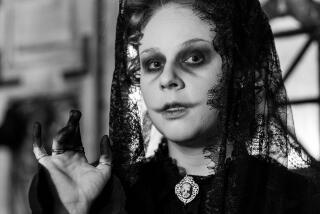Puzzle Palace : Jerry Slocum’s 10,000-Piece Collection Has Tangrams and Disentanglements, Dexterity and Sequential Motion Challenges
- Share via
Two years ago, Jerry Slocum built a “museum” in his Beverly Hills garden to house his collection of more than 10,000 puzzles. The collection had long since outgrown the bedroom it had inherited when Slocum’s older son went off to college. Slocum and his wife, Margot, had a Murphy bed built into the museum, which is used by visiting family members. But it has another purpose.
“Puzzle collectors visit with us,” Slocum says. “And we have a house rule that anybody who takes a puzzle apart puts it back together; therefore we have to have the necessary accommodations. If they take too many puzzles apart, we can keep them for an extended stay.”
Chicago-born Jerry Slocum first became interested in puzzles at age 8. Whenever his parents visited New York or San Francisco, they brought back puzzles as souvenirs. “I still have a little barrel puzzle they brought me from San Francisco--a puzzle of interlocking wood pieces,” Slocum says.
By the time Slocum went off to the University of Illinois he had amassed 300 puzzles. In 1954 he earned a bachelor’s degree in mechanical engineering with a minor in psychology and moved to Los Angeles. “I was very interested in experimental psychology and equipment design,” Slocum says, “and that led me into my career, which is indirectly related to puzzle solving.” Slocum works for Hughes Aircraft Co. He has been involved in the design of displays and controls for pilots, particularly in military aircraft--”the interface between the pilot and the electronics. Presenting information so that it’s easily interpretable.”
A large selection of Slocum’s puzzles is on show at the Craft and Folk Art Museum, Los Angeles, through Feb. 22. Some of them are tangrams , in which you put together geometric pieces to form a picture. One Chinese ivory tangram is carved with horsemen, dragons and birds of paradise.
Slocum likes best puzzles that look simple but are difficult to work out, such as two pieces of wood that can be fitted together to form a pyramid. He took that puzzle onto the Johnny Carson Show in October, and Carson was unable to solve it. Slocum has bought puzzles that have taken him more than a year, on and off, to solve. “One of the things I really enjoy,” he says, “is buying a box that contains pieces for more than one puzzle and then figuring out what the puzzles are, and putting them in the right piles. Sometimes pieces are missing, of course.”
There are disentanglement puzzles. (The two-nail puzzle is the best-known example.) There are sequential motion puzzles such as solitaire and the sliding-block puzzle invented by Sam Loyd in the 1870s, a puzzle that inspired both Larry Nichols and Erno Rubik to design their cube puzzles. (Jerry Slocum is a friend of Rubik, whose name was signed just before mine in the Slocum visitors’ book.)
And there are maddening dexterity puzzles, in which the object is to maneuver balls into holes. A large range of these was made by the British firm R. Journet. Slocum is especially proud of a rare example that he obtained, through an intermediary, from Journet’s son in England. It is called the Niagara Puzzle and was made during World War I. In the back of the puzzle, Journet concealed a hacksaw blade, a small compass and a map; the puzzles were sent to prisoners of war in Europe.
Another interest of Jerry Slocum’s is pottery puzzle jugs. These have a series of holes around the rim, so that if you drink from them as you would from a normal vessel, the drink would spill over you. They were popular in German, Dutch and English taverns from the 16th to the 18th century.
“When a stranger came in,” Slocum says, “they would serve his beer or wine in a puzzle jug, and then everyone would laugh when the stranger spilled his drink, because he didn’t know the secret. The secret is that there’s a hole at the bottom of the puzzle jug that goes through a hollow--basically like a straw--through the handle of the puzzle jug and around the hollow rim; and if you put your fingers over all the holes but one, and you suck through the remaining hole, it acts just like a straw, and you can drink the whole thing without spilling a drop.”
Drinks are served (not in puzzle jugs) at a party Slocum holds each December for puzzle collectors and designers. “But I don’t think anybody would even get a beer until they’d been at the party for an hour or two,” Slocum says, “because they’re so interested in the discussion and meeting the people they’ve been in touch with, or new people.”
Slocum is interested in puzzles from all over the world. He tries to find out when and where a given puzzle was introduced and how the same puzzle changes form in different cultures. I asked whether there is s any puzzle that he has hunted for all his life and still has not found. “There is a famous book--by Prof. Angelo Hoffmann, who was a magician; his real name was Angelo Lewis--’Puzzles Old and New’ (1893). And the puzzles that are in that book we refer to, to this day, as Hoffmann puzzles. And those are collectors’ items par excellence . I would love to get every puzzle that’s in that book. I have maybe half of them.”
More to Read
The biggest entertainment stories
Get our big stories about Hollywood, film, television, music, arts, culture and more right in your inbox as soon as they publish.
You may occasionally receive promotional content from the Los Angeles Times.










